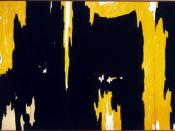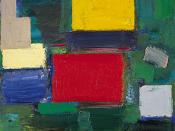Abstract Expressionism sprung from the social conditions of the first half of 19th Century America, a period that was characterised by the Great Depression of the 1930s, economic, social and political instability, two devastating world wars and a consequent inward turn and adoption of isolationist policies in the USA. Artistically, the era of modernism was coming to an end, and realist and Regionalist painting were still dominant. In this context, the Abstract Expressionists arose with a radical, new style of painting that marked a turn away from the figurative, toward an abstract idiom that was more open to metaphor and a universal artistic vocabulary. This rejection of the representational offered more than a richer, purer emotional scope - it allowed the Abstract Expressionists to respond to the tragic, global effects of modernity and the repercussions of traumatic global events on individuals by asserting a confident, American, individualistic and masculine style of art.
Abstract Expressionism embodied and showcased on a world scale the more positive values of the USA - that is, the values of a liberal, free enterprise society with an emphasis on self-criticism and discussion. Hence, the movement was canonised, promoted and supported by such key American institutions as the international program at Museum of Modern Art (MoMA), the CIA and the Congress of Cultural Freedom.
While the predominant political and social conditions of the time were key in the promotion of Abstract Expressionism as a new and distinctively American-style painting, many art critics emphasised the existentialist and process-driven elements of the new movement. The process, typical of Jackson Pollock, of dribbling, throwing, dropping and splattering paint across canvas came to be known as "action painting", and emphasises the canvas as an area in which to act, not just to merely reproduce objects or people. The aesthetic effect...


